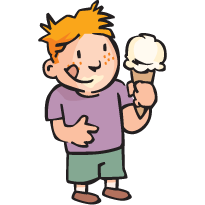Boston Children's Museum
308 Congress Street, Boston, MA 02210
617-426-6500
© Boston Children’s Museum 2025
Website Design by JackrabbitCooking activities are great for teaching kids how to use measurement tools, giving them a chance to apply math skills like counting, adding, multiplying, etc. In addition, when you give them a chance to design their own recipe, children have to rely on estimation, problem solving and other critical science, math and engineering skills.
For this first session, you will only be using cream, sugar and vanilla as ingredients, and the 2 sizes of Ziploc bags, ice and salt as materials. Management of the ingredients will be much easier if they are divided into several cups, with 2 or 3 teams sharing a set of cups. Make sure to label the cups with the ingredient that is in them—sugar and salt can look very similar!
For an even more satisfying method, check out the Ice Cream Science – A New Recipe activity, which uses buckets of ice and coffee cans.

Ask your students if they have ever made ice cream at home before. How did they do it? What flavor did they make? Did they ever try to invent their own recipe? Have them brainstorm a list of ingredients they think are needed to make ice cream. Once you have a list, tell them that they’ll first learn how to make vanilla ice cream and that later they will invent their own recipes.
Can you make ice cream using the ingredients you’ve been supplied?
After your students have been mixing and shaking their ice cream for a few minutes, ask them if they notice anything happening. How do the bags feel? They should keep shaking and squeezing their bags during this discussion.
When everyone’s ice cream is done, give kids a chance to taste their creations. Make sure you record how long it took for them to make ice cream. Ask them how it tastes. Is there anything they would change about it? What other flavors might they try? What would happen if they just used ice to make their ice cream?